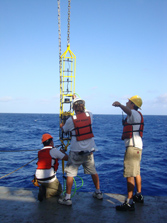TAAM

 The
Thermistor Array/Acoustic Modem (TAAM) was designed to collect a temperature
profile of the bottom 200 meters of the ocean. Ten thermistors, instruments
that measure temperature, are attached to a cable that floats vertically
from the seafloor, with the sensors spaced between 5 and 20 meters apart. These
are setup to talk to the Observatory or record internally. Also on the mooring
is a fluorometer (below) and an acoustic modem. The modem can talk to other
modems, for instance on nearby autonomous mooring systems.
The
Thermistor Array/Acoustic Modem (TAAM) was designed to collect a temperature
profile of the bottom 200 meters of the ocean. Ten thermistors, instruments
that measure temperature, are attached to a cable that floats vertically
from the seafloor, with the sensors spaced between 5 and 20 meters apart. These
are setup to talk to the Observatory or record internally. Also on the mooring
is a fluorometer (below) and an acoustic modem. The modem can talk to other
modems, for instance on nearby autonomous mooring systems.
With no one aboard the R/V Kilo Moana who was 200 meters tall - tall enough to pick up the TAAM and drop it in the water, - the TAAM was one of the harder pieces of the observatory to deploy. Faced with a lack of giants, a meticulous plan was constructed to lower the TAAM into the water, meter by meter. First the anchor plunged into the water. Then scientists and sailors in hard hats and life vests unspooled 200 meters of cable after it, pausing every so often to attach the thermistors.
At the end of the 200 meters cable, the hard hat wearers shackled 5 strings of glass balls covered in yellow shells, which look like hard hats themselves. The glass balls are perfectly round to withstand the pressure and are sealed to float, keeping the cable extended vertically above the anchor.

Periodically, cold water from north of Maui spills over a ridge north of Oahu into the basin in which Station Aloha is located. These oceanographic phenomena have come to be called Cold Events. They are of interest to researchers because they bring a large amount of change in temperature, current and salinity to a generally very static environment. The Thermistor Array/Acoustic Modem(TAAM), with its 200 meters of temperature measurements, will be able to record these cold events.